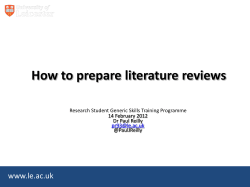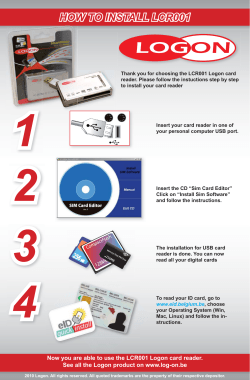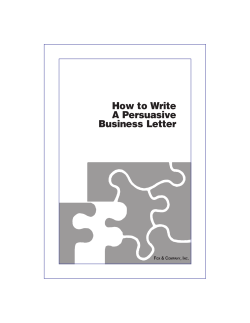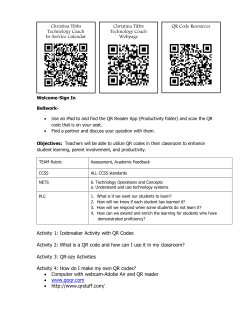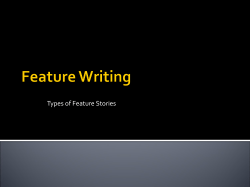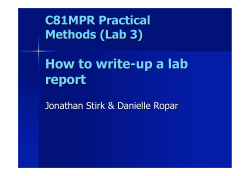
Feature Articles
Feature Articles What are feature articles? A feature story is an article that is not meant to report breaking news but instead takes an in-depth look at issues behind a news story, often concentrating on background events, persons or circumstances. What are the components of feature articles? Feature stories place a greater emphasis on facts that have human interest. Features put people in the story; they make the reader think and care. Finding an angle Angle- a way of looking at the subject of your article You may write about anyone or anything in a feature article as long as you have a unique angle. Make your readers look at that subject in a new way Finding an angle Example: Subject of article: Mrs. Macomber You don’t want to write a list of everything about me and my life. That would be boring. Instead, pick one aspect of me/my life that you think readers will relate to or find interesting. Angle: Macomber’s experience dancing for Third Eye Blind in Lion’s 1999 halftime show News v.s. Feature writing News articles Feature articles Timeliness- deals with current Timeless- can usually be published event and must be published soon anytime Follows inverted pyramid structure Has a more narrative format with a definite beginning, middle & end Stresses the 5Ws and 1H Does not necessarily have 5Ws and 1H; delves deep into subject, giving a lot of details Reader can read 1-2 paragraphs and understand topic Reader must read entire article to really understand the subject Feature article leads Remember, we don’t have the 5Ws and 1H with feature articles. Feature leads, sometimes called delayed leads, unfold more slowly. They allow the writer to tell a story in a more traditional, narrative way. The objective, of course, is to draw the reader into the story, to make them want to read more. Think of the lead as more of an “attention getter” from your other English classes. Feature leads must introduce your subject and your angle in an interesting way. Feature article leads Feature leads often use anecdotesshort stories about the subject. Think of them as scene-setting. Feature leads are usually 2-3 paragraphs long! Sample feature article lead Here’s a Pulitzer Prize winning example by Andrea Elliott of “The New York Times”: The young Egyptian professional could pass for any New York bachelor. Dressed in a crisp polo shirt and swathed in cologne, he races his Nissan Maxima through the rain-slicked streets of Manhattan, late for a date with a tall brunette. At red lights, he fusses with his hair. What sets the bachelor apart from other young men on the make is the chaperon sitting next to him -- a tall, bearded man in a white robe and stiff embroidered hat. Nutgraf The nutgraf is where the feature writer lays out for the reader exactly what the story is all about. It usually follows the first few paragraphs of the scene-setting or story-telling the writer has done. A nutgraf can be a single paragraph or more. Sample nutgraf Continued from the Andrea Elliott article: "I pray that Allah will bring this couple together," the man, Sheik Reda Shata, says, clutching his seat belt and urging the bachelor to slow down. Christian singles have coffee hour. Young Jews have JDate. But many Muslims believe that it is forbidden for an unmarried man and woman to meet in private. In predominantly Muslim countries, the job of making introductions and even arranging marriages typically falls to a vast network of family and friends. In Brooklyn, there is Mr. Shata. Week after week, Muslims embark on dates with him in tow. Mr. Shata, the imam of a Bay Ridge mosque, juggles some 550 "marriage candidates," from a gold-toothed electrician to a professor at Columbia University. The meetings often unfold on the green velour couch of his office, or over a meal at his favorite Yemeni restaurant on Atlantic Avenue. Sample nutgraf So now we know – this is the story of a Brooklyn imam who helps bring young Muslim couples together for marriage. Elliott could just as easily have written the story with a hard-news lead like this: An imam based in Brooklyn says he works as a chaperone with hundreds of young Muslims in an effort to bring them together for marriage. That’s certainly quicker. But it’s not nearly as interesting as Elliott’s descriptive, well-crafted approach. The remainder of the article Let the story unfold naturally. The conclusion should pack a punch. Give us something interesting! An easy way to end your article is to pick a particularly poignant quotation about the subject. Some feature article DON’Ts NEVER: Tell the reader what to do. Example: “So the next time you’re walking down Main Street, stop in at Bagel Junction…” Nobody likes to be ordered around. Knowingly use a cliché. Example: “Actions speak louder than words.” Use the first-person singular (“I,” “me”) or plural (“we,” “us” “our”), unless it’s a first-person story. Example: don’t write “He knows more about movies than anyone I’ve ever met…” even if it’s true. The article isn’t about you!
© Copyright 2025
